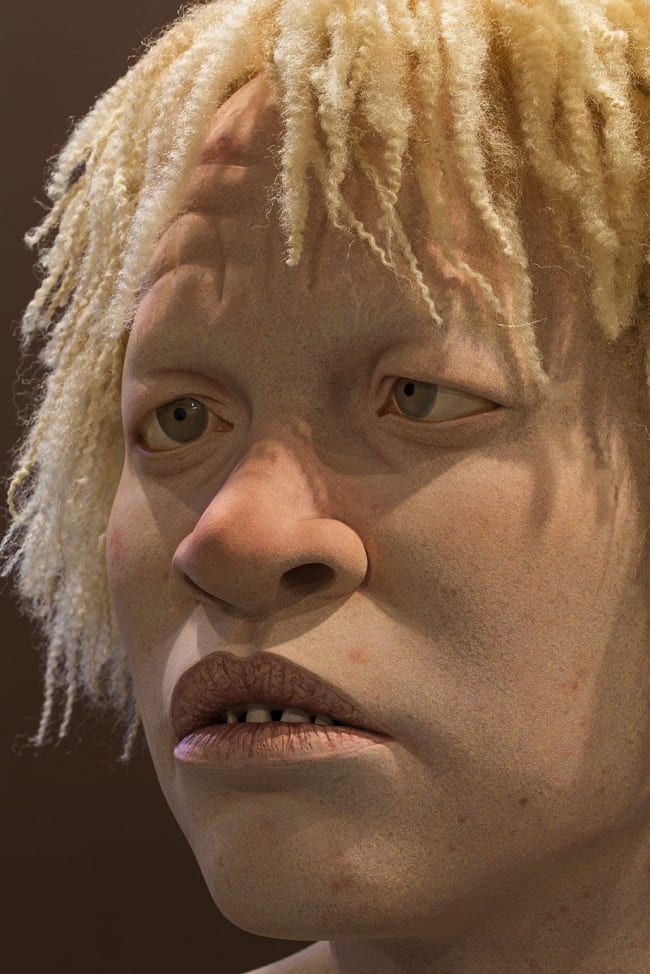Tip Toland has always been concerned with the figure: Her early work was primarily surrealistic, inspired by late Gothic artist Fra Angelico, Persian miniatures, and Surrealists René Magritte, Giorgio de Chirico, and Remedios Varo. Her current works on exhibition at the Portland Art Museum (February 1 – May 11, 2014) are exquisitely super-realist monumental ceramic portraits and a twice-life-size full figure representing Mother Africa. They have a powerful political subtext, addressing the plight of African albino children who face horrific persecution.
Toland addresses this both in her work- the scale of which draws one into exaggerated intimacy with her subjects- and her artist statement:
“In Tanzania, horrific acts of mutilation have been taking place due to prejudice, ignorance, and superstition. According to lore, people with albinism are viewed as ghosts or bad omens. Despite this delusion, indigenous shamans have conjured up magical potions from body parts to bring wealth and good luck. Potions have been used in a variety of contexts: gold miners have poured them on the ground and fishermen have poured them on their nets or in their canoes. As a result, body parts from people with albinism have commanded a high price and grave robbers have harvested them. When the graves run out, living people are attacked and mutilated for their arms, legs, hair, genitalia, and blood. Ultimately the bottom line from these superstitions and prejudices is economic —in a country in which the average annual income is less than $450, a limb from a person with albinism can bring anywhere from $500 to $2,000. Africans with albinism have also been attacked in neighboring countries, with body parts smuggled into Tanzania.”
Toland states that Tanzania is awakening to this problem. Shamans that make such potions risk losing their licenses, there are boarding schools for people with albinism, people with albinism have been appointed to positions in the Tanzanian Parliament and poachers who commit human mutilation risk a death sentence. However, Toland states that the situation in the continent remains “fraught with paranoia and anxiety” for people with albinism.
Above image: Tip Toland, African Child with Albanism, clay, paint, pastel, and synthetic hair
30″H x 28″W x 20″D. Photograph courtesy of the artist.
Any thoughts about this post? Share yours in the comment box below.

Tip Toland, African Teen with Albinism, stoneware, clay, paint, chalk pastel and synthetic hair, 31″H x 32″W x 20″D. Additional image shows the artist with her sculpture.


Tip Toland, African Child with Albinism 3, stoneware, clay, paint, chalk pastel and synthetic hair, 30″H x 28″W x 19D


Tip Toland, African Child with Albinism 4, stoneware, clay, paint, chalk pastel and synthetic hair, 31″H x 28″W x 19″D


A piece from Tip Toland’s exhibition on albinism. Stoneware clay, paint, chalk pastel and synthetic hair, 31″H x 28″W x 19″D


Tip Toland, African Child with Albanism, clay, paint, pastel, and synthetic hair, 30″H x 28″W x 20″D




Tip Toland, Africa, clay, paint, pastel and synthetic hair, 52″H x 9’11″W x 54″D. Additional image is an installation view showing Toland to the right. All photographs courtesy of the artist.
Visit a site for albinism in Tanzania and East Africa

I am moved
Orly, there are many ways of raising awareness. One of them is art, in all of its forms and modes of expression. Would you express the same sentiment to Goya for his profound etchings, “The Disasters of War”? And if there are “better ways of raising awareness”, where are they? The media rarely touches a subject as disturbing as this. So, hats off to Ms. Toland for her courageous exhibition. Personally, I am most impressed with her skill and the sheer content of her work.
Disturbingly exoticist and othering. There are better ways of raising awareness than a ceramic freakshow.
Immensely moved by your work and the story around it.
Thank you,
Teri
Really moved by your work and the story around it.
Thank you.
Teri